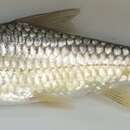en
names in breadcrumbs


Die Laeveld grootskub-geelvis (Labeobarbus marequensis) is 'n varswater vis wat natuurlik wyd verspreid voorkom vanaf die onderste gedeelte van die Zambezirivier suidwaarts tot by die Pongolarivier. In Engels staan die vis bekend as die Lowveld largescalescale yellowfish.
Die vis het groot skubbe en daar is twee pare baarde om die mond. Die vis word tot 470 mm lank en weeg tot 6.0 kg. Die Suid-Afrikaanse hengel rekord is 5.75 kg en die Zimbabwe rekord is 4.11 kg.
Die Laeveld grootskub-geelvis (Labeobarbus marequensis) is 'n varswater vis wat natuurlik wyd verspreid voorkom vanaf die onderste gedeelte van die Zambezirivier suidwaarts tot by die Pongolarivier. In Engels staan die vis bekend as die Lowveld largescalescale yellowfish.
Labeobarbus marequensis és una espècie de peix pertanyent a la família dels ciprínids.[4] Es troba a Àfrica: des del riu Zambezi fins a la conca del riu Pongola a Moçambic, Sud-àfrica, Swazilàndia, Zàmbia i Zimbabue.[5][6][7][8][9][10][11][12][13][14][15][16][17] És un peix d'aigua dolça, potamòdrom, bentopelàgic i de clima tropical (11°S-27°S).[18][19] Fa 47 cm de llargària màxima i 6.000 g de pes.[18][20] Menja sobretot algues i larves d'insectes aquàtics, tot i que també es nodreix en menor mesura de peixets, caragols, musclos d'aigua dolça i insectes terrestres que cauen a l'aigua (com ara, escarabats i formigues).[18] Es reprodueix a la primavera i l'estiu migrant riu amunt per a fer-ho.[18] És inofensiu per als humans.[18]
Labeobarbus marequensis és una espècie de peix pertanyent a la família dels ciprínids. Es troba a Àfrica: des del riu Zambezi fins a la conca del riu Pongola a Moçambic, Sud-àfrica, Swazilàndia, Zàmbia i Zimbabue. És un peix d'aigua dolça, potamòdrom, bentopelàgic i de clima tropical (11°S-27°S). Fa 47 cm de llargària màxima i 6.000 g de pes. Menja sobretot algues i larves d'insectes aquàtics, tot i que també es nodreix en menor mesura de peixets, caragols, musclos d'aigua dolça i insectes terrestres que cauen a l'aigua (com ara, escarabats i formigues). Es reprodueix a la primavera i l'estiu migrant riu amunt per a fer-ho. És inofensiu per als humans.
Labeobarbus marequensis, engl. Largescale Yellowfish[1], auf Afrikaans auch Grootskub-Geelvis[2], ist eine Karpfenfischart, die endemisch nur im südlichen Afrika vorkommt.
Labeobarbus marequensis ist im südlichen Afrika zwischen den Breitengraden 11° S und 27° S in den Ländern Südafrika (Gauteng, KwaZulu-Natal, Limpopo und Mpumalanga), Eswatini, Malawi und Mosambik[3] weit verbreitet. Die Fischart kommt im mittleren und unteren Sambesi, dem Kariba-Staudamm[4], sowie im Pongolo-Flusssystem vor. L. marequensis bevorzugt Fließgewässer mit ganzjährigem Wasserstand und einige Stauseen.[2] L. marequensis taucht zwar in Staustufen auf, doch ist dies nicht sein ursprünglicher Lebensraum. Größere Exemplare leben in tiefen Pool mit steinig, felsigem Grund.[3]
Labeobarbus marequensis zeigt eine große morphologische Variabilität. Einige Populationen unterscheiden sich stark voneinander. Hier sind die taxonomischen Untersuchungen noch nicht vollständig abgeschlossen.[3] Die Fischart wird durchschnittlich ca. 47 Zentimeter lang und sechs Kilogramm schwer.[2]
L. marequensis hat ein breites Ernährungsspektrum. Er ernährt sich von Algen und Larven von Wasserinsekten und bei zunehmender Größe auch von Kleinfischen, Schnecken und Süßwassermuscheln. Teilweise nimmt er auch ins Wasser gefallene Insekten von der Oberfläche auf. Die Laichzeit findet im Frühling statt. Die geschlechtsreifen Fische wandern in den von Regenfällen zum Hochwasser angestiegenen Flüssen in die Stromschnellen hinauf.[2]
Labeobarbus marequensis ist ein Sportfisch für Angler.[2]
Der Bau von Staudämmen und die Degradation ihres natürlichen Lebensraumes bedrohen ihren Bestand. Der Bau von Fischtreppen und die Erhaltung ihres Biotops sind Maßnahmen, die getroffen wurden. Die Art ist derzeit als „least concern“ eingestuft.[3]
Labeobarbus marequensis, engl. Largescale Yellowfish, auf Afrikaans auch Grootskub-Geelvis, ist eine Karpfenfischart, die endemisch nur im südlichen Afrika vorkommt.
The largescale yellowfish or Lowveld largescale yellowfish (Labeobarbus marequensis) is a species of fish in the family Cyprinidae. An African freshwater fish found from the Zambezi south to the Pongola River.
The largescale yellowfish or Lowveld largescale yellowfish (Labeobarbus marequensis) is a species of fish in the family Cyprinidae. An African freshwater fish found from the Zambezi south to the Pongola River.
Labeobarbus marequensis Labeobarbus generoko animalia da. Arrainen barruko Actinopterygii klasean sailkatzen da, Cyprinidae familian.
Labeobarbus marequensis Labeobarbus generoko animalia da. Arrainen barruko Actinopterygii klasean sailkatzen da, Cyprinidae familian.
Labeobarbus marequensis is een straalvinnige vissensoort uit de familie van eigenlijke karpers (Cyprinidae).[2] De wetenschappelijke naam van de soort is voor het eerst geldig gepubliceerd in 1841 door Smith.
De soort staat op de Rode Lijst van de IUCN als niet bedreigd, beoordelingsjaar 2007.[1]
Bronnen, noten en/of referenties大鱗黃魮(学名:Labeobarbus marequensis)为輻鰭魚綱鯉形目鲤科的其中一種,分布於非洲三比西河中下游至澎哥洛河流域,體長可達47公分,棲息在流動的水域,屬雜食性,以藻類、甲殼類、貝類及昆蟲等為食,可做為遊釣魚類。